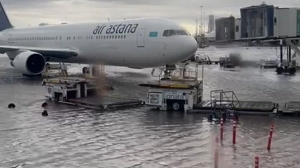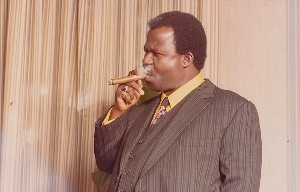- Home - News
- TWI News | TV
- Polls
- Year In Review
- News Archive
- Crime & Punishment
- Politics
- Regional
- Editorial
- Health
- Ghanaians Abroad
- Tabloid
- Africa
- Religion
- Election 2020
- Coronavirus
- News Videos | TV
- Photo Archives
- News Headlines
- Press Release
General News of Friday, 16 November 2012
Source: The Herald Newspaper
Red Alert: Akufo-Addo wanted in Kenya
Nana Akuff-Addo and the New Patriotic Party (NPP), have often cited Kenya as a shining example for their “Free Education” promise, but painstaking investigations have revealed this claim to be false, and that the policy has rather become a curse unto the country that is many times richer than Ghana.
According to investigations conducted by some Americans, Kenya which started experimenting with the policy some nine years ago, now needs over 80, 000 qualified teachers, school blocks, desks, textbooks and other essential materials; they are presently crying for donors to come their aid to sustain the political promise made in 2003, by Kenya President Mwai Kibaki.
The investigations done by an American journalist based in Austin-Texas, John Burnett for a media organization called “NPR News” said recently that “The Kabiru-ini principal had to send home 100 girls, nearly a third of the school, to ask their parents for money for things like teachers’ salaries, examinations, uniforms and new buildings”.
John Burnett revealed in his July 2012, report that “A study published by Britain’s Sussex University in 2007 found that Kenya’s free schools were a matter of political expediency… not adequately planned and resourced, and as a result, there have actually been more dropouts and a falling quality of education”.
Below is the full story unedited
July 16, 2012
Parents on U.S students often complain about things like too many standardized tests or unhealthful school lunches. Kenya wishes it had such problems. Kenya dropped or greatly reduced fees at public school nearly a decade ago in an effort to make education available to all children.
On one level, it’s been a success-school attendance has soared. Yet this has also exacerbated chronic problems that include shortages of qualified teachers, books, desks and just about every other basic need.
Kenya is struggling to have universal primary by 2015, but its experience highlights the frustrations of a poor country trying to meet such goals. When visitors arrive at a Kenya primary school, it’s something of an event.
At Amboni primary School, boundaries of the spectacular Aberdeare National Park and game reserve, children stream out of their classrooms and break into a song: “Everybody today is happy to see you…”
A decade or more ago, many of these kids might not have been in school. They would have been hauling water, tending sheep or working in farm fields. Still Kenya’s nine-year-old experiment with free education is not working out as people had hoped.
Getting Rid Of Fees
In 2003, Kenyan President Mwai Kibaki eliminated expensive school fees for primary schools. The move honored a political promise and followed a trend of free public schools in the neighboring states of Tanzani, Ethiopia, Uganda and Malawi.
“I come from a very poor family such that I was always going home [to collect] school fees,” says Agnes Munuhe, a 50-year-old teachers’ adviser, the 11th of 13 children of a subsistence farmer and his three wives in Central Kenya.
Because her parents could not always afford the fees, Munuhe didn’t learn to read and write until she was 16 and did not finish high school until she was 25. When Kenya dropped school fees the result was dramatic. Public school enrollment went from 6.1 million to 7.4 million in just two years, from 2002 to 2004, and has continued climbing. The increase has included many girls whose families had held them back in this conservative society.
But Kenya’s tottering school system could not handle the flood of new students, and the situation has not improved as the initial crush of the primary school students works its way through the high schools.










